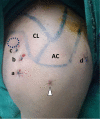Osteoid osteoma (OO) of the coracoid: a case report of arthroscopic excision and review of literature
- PMID: 27163073
- PMCID: PMC4849236
- DOI: 10.1051/sicotj/2015016
Osteoid osteoma (OO) of the coracoid: a case report of arthroscopic excision and review of literature
Abstract
Osteoid osteoma (OO) of the coracoid is a rare entity that may present with variable symptoms from shoulder leading to delay in diagnosis and treatment. We present the clinical and radiological findings and management of one such case along with a review of similar cases reported in the literature. There was a delay of 2 years in diagnosis, which was later confirmed by computed tomography in addition to magnetic resonance imaging (MRI). The lesion was accessed arthroscopically and excised by unroofing and curettage. "OO" should be included in the differential diagnosis of shoulder pain in young patients not responding to long-term conservative treatment. Arthroscopic excision and curettage provide a good choice for management, with low morbidity and rapid recovery.
Keywords: Arthroscopic excision; Coracoid; Osteoid osteoma; Shoulder; Technique.
Figures




Similar articles
-
Osteoid osteoma of the base of the coracoid process - A case report.Int J Surg Case Rep. 2020;66:162-164. doi: 10.1016/j.ijscr.2019.11.066. Epub 2019 Dec 9. Int J Surg Case Rep. 2020. PMID: 31862658 Free PMC article.
-
Hip arthroscopy for excision of osteoid osteoma of femoral neck.Arthrosc Tech. 2014 Feb 6;3(1):e145-8. doi: 10.1016/j.eats.2013.09.011. eCollection 2014 Feb. Arthrosc Tech. 2014. PMID: 24749036 Free PMC article.
-
Rare encounter: Osteoid osteoma of the coracoid process base - A case report and in-depth literature review.Int J Surg Case Rep. 2025 Jan;126:110826. doi: 10.1016/j.ijscr.2025.110826. Epub 2025 Jan 4. Int J Surg Case Rep. 2025. PMID: 39761622 Free PMC article.
-
OSTEOID OSTEOMA OF THE CORACOID PROCESS: CASE REPORT WITH LITERATURE REVIEW.Acta Clin Croat. 2016 Sep;55(3):505-9. Acta Clin Croat. 2016. PMID: 29046018 Review.
-
A misdiagnosed case of osteoid osteoma of the talus: a case report and literature review.BMC Musculoskelet Disord. 2017 Jan 23;18(1):35. doi: 10.1186/s12891-017-1413-8. BMC Musculoskelet Disord. 2017. PMID: 28114974 Free PMC article. Review.
Cited by
-
Osteoid Osteoma in an Adult Wheelchair Basketball Player Mimicking Musculoskeletal Shoulder Pain: Red Flag or a Red Herring?Tomography. 2022 Feb 7;8(1):389-401. doi: 10.3390/tomography8010032. Tomography. 2022. PMID: 35202197 Free PMC article.
-
Arthroscopic treatment of intra-articular osteoid osteoma in the bicipital groove. A case report.Int J Surg Case Rep. 2022 Dec;101:107794. doi: 10.1016/j.ijscr.2022.107794. Epub 2022 Nov 21. Int J Surg Case Rep. 2022. PMID: 36434875 Free PMC article.
-
Osteoid osteoma of the base of the coracoid process - A case report.Int J Surg Case Rep. 2020;66:162-164. doi: 10.1016/j.ijscr.2019.11.066. Epub 2019 Dec 9. Int J Surg Case Rep. 2020. PMID: 31862658 Free PMC article.
-
Radiofrequency ablation of osteoid osteoma at the base of the coracoid process: Report of two cases.Clin Case Rep. 2024 Jun 21;12(7):e9098. doi: 10.1002/ccr3.9098. eCollection 2024 Jul. Clin Case Rep. 2024. PMID: 38911920 Free PMC article.
-
Arthroscopic excision of intra-articular sub-periosteal osteoid osteoma of elbow: a case report.SICOT J. 2018;4:25. doi: 10.1051/sicotj/2018021. Epub 2018 Jun 29. SICOT J. 2018. PMID: 29956662 Free PMC article.
References
-
- Jaffe HL (1935) Osteoid osteoma of bone. Radiology 45, 319.
-
- Dorfman HD, Czerniak B (1998) Benign osteoblastic tumors, in Bone tumors. Gery L, Editor St. Louis, Mosby; pp. 85–104.
-
- Mosheiff R et al. (1991) Osteoid osteoma of the scapula: a case report and review of the literature. Clin Orthop 262, 129–131. - PubMed
-
- Kaempffe FA (1994) Osteoid osteoma of the coracoid process. Excision by posterior approach. A case report. Clin Orthop Relat Res 301, 260–262. - PubMed
-
- Ogose A, Sim FH, O’Connor MI, Unni KK (1999) Bone tumors of the coracoid process of the scapula. Clin orthop 358, 205–214. - PubMed
LinkOut - more resources
Full Text Sources
Other Literature Sources
